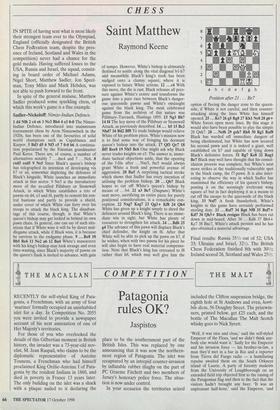CHESS
Saint Matthew
Raymond Keene
IN SPITE of having sent what is most likely their strongest team ever to the Olympiad, England (officially designated the British Chess Federation team, despite the pres- ence of Ireland, Scotland and Wales in the competition) never had a chance for the gold medals. Having suffered losses to the USA, Russia and Israel, the squad, consist- ing in board order of Michael Adams, Nigel Short, Matthew Sadler, Jon Speel- man, Tony Miles and Mark Hebden, was not able to push forward to the front.
In spite of the general malaise, Matthew Sadler produced some sparkling chess, of which this week's game is a fine example.
Sadler—Nickoloff: Nimzo-Indian Defence.
1 d4 Nf6 2 c4 e6 3 Nc3 Bb4 4 e3 0-0 The Nimzo- Indian Defence, introduced into mainstream tournament chess by Aron Nimzowitsch in the 1920s, has been one of the favourites of solid world champions such as Capablanca and Karpov. 5 Bd3 d5 6 Nf3 c5 70-0 b6 A continua- tion popularised by the Estonian grandmaster Paul Keres. There are, of course, a number of alternatives notably 7 ... dxc4 and 7 ... Nc6. 8 cxd5 exd5 9 Ne5 Since Black's queen's bishop has telegraphed its intention of developing via b7 or a6, somewhat depleting the defences of Black's kingside, White launches an immediate attack in that sector. 9 Ne5 is the introductory move of the so-called Pillsbury or Stonewall Attack, in which White establishes a trio of pawns on d4, e3 and f4, partly to cement his cen- tral bastions and partly to provide a shield, under cover of which White can ferry over his troops to attack the black king. The disadvan- tage of this course, though, is that White's queen's bishop may get locked in behind its own pawn chain. In general, one can say of such situ- ations that if White wins it will be by direct mid- dlegame attack, while if Black wins, it is because he survives to the endgame phase. 9 ... Re8 10 Bb5 Re6 11 Net a6 12 Ba4 White's manoeuvre with his king's bishop may look strange and even time-wasting, since Black's majority of pawns on the queen's flank is invited to advance, with gain of tempo. However, White's bishop is ultimately destined to nestle along the vital diagonal bl-h7 and meanwhile Black's king's rook has been nudged onto a clumsy square, where it is exposed to future White actions. 12 ... c4 With this move, the die is cast. Black releases all pres- sure against White's centre and transforms the game into a pure race between Black's danger- ous queenside pawns and White's onslaught against the black king. The most celebrated game from the archives of this nature was Pillsbury–Tarrasch, Hastings 1895. 13 Ng3 Bb7 14 f4 The key move of the Pillsbury or Stonewall Attack, as previously described. 14 ... b5 15 Bc2 Nbd7 16 Bd2 Bf8 To trade bishops would relieve White of his problem piece. White's mission now is to find some way of bringing his dormant queen's bishop into the attack. 17 Qf3 Qc7 18 Bf5 ReeS 19 Nh5 Bc6 One might ask why Black never trades knights on e5. The answer is, imme- diate tactical objections aside, that the opening of the f-file after ...Nxe5, fxe5 would always grant White a fresh and powerful avenue of aggression. 20 Ba5 A surprising tactical stroke which shows that Sadler has every intention of utilising the problem bishop. 20 ...Qb7 Black hopes to cut off White's queen's bishop by means of ... b4. 21 a3 Be7 (Diagram) White's next move, sacrificing an entire piece for purely positional considerations, is a remarkable con- ception. 22 Nxg7 Kxg7 23 Qg3+ Kf8 24 Qh4 White has given up a knight simply to shred the defences around Black's king. There is no imme- diate win in sight, but White has plenty of resources to strengthen his attack. 24 ...Bd6 25 g4 The advance of this pawn will displace Black's chief defender, the knight on f6. After that White will be able to pick up the pawn on h7, if he wishes, when with two pawns for his piece he will also begin to have real material compensa- tion. Note that Black's king has retreated to f8 rather than h8, which may well give him the Position after 21 . . . Be7 option of fleeing the danger zone to the queen- side, if White is not careful, and then counter- attacking along the lines White has himself opened. 25 ...Ke7 26 g5 Rg8 27 Khl Ne8 28 g6+ White forces open more lines. By this stage it would also have been possible to play the simple 28 Qxh7. 28 ...Nef6 29 gxh7 Rh8 30 Rgl Raffi Black has warded off immediate dangers of being checkmated, but White has now secured his second pawn and it is indeed a giant, well established on h7 and capable of tying down Black's defensive forces. 31 Rg7 Ke8 32 Ragl Be7 Black may well have thought that his consol- idation process was complete, but White's next move strikes at the traditionally vulnerable spot in the black camp, the f7-pawn. It is also inter- esting to observe the way in which Sadler has maximised the efficiency of his queen's bishop, posting it on the seemingly irrelevant wing square a5 but in fact deploying it as a means to cut off the escape to the queenside of the black king. 33 MC A fresh thunderbolt. White's knights in this game have certainly performed sterling duty. 33 ... Rxf7 34 Bg6 Nf8 35 Bxf7+ Kd7 36 Qh3+ Black resigns Black has been cut down in mid-board. After 36 ... Kd6 37 Bb4+ Kc7 38 Bxe7, White's attack persists and he has also obtained a material advantage.
Final results: Russia 351/2 out of 52; USA 33; Ukraine and Israel, 321/2. The British Chess Federation finished 8th with 301/2; Ireland scored 26, Scotland and Wales 251/2.










































































 Previous page
Previous page